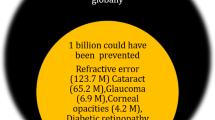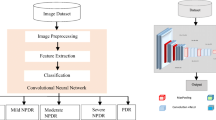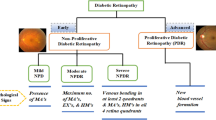Abstract
Diabetic retinopathy (DR) is one of the main retinal abnormalities which is asymptomatic and is the main cause of vision loss in diabetic patients. The computer-aided diagnosis systems based on image processing not only facilitate the doctor but also decrease the diagnosis time. This work represents the automated detection of one of the red lesion, i.e., hemorrhages, which are one of the most distinctive signs of retinal diseases in diabetic patients. In the proposed method, the foremost step is to enhance the image quality by eliminating the background noise and nonuniform illumination. This is achieved by applying the methods such as image contrast enhancement and normalization. The subsequent step is to segment the blood vessels from hemorrhages (using scale-based method) as both of them have the same color. The last step is to delineate the hemorrhages by exploiting the gamma correction and global thresholding techniques. The proposed method has achieved specificity (SP) of 84%, sensitivity (SN) of 87%, and an accuracy of 89 % on the DIARETDB1 database.





Similar content being viewed by others
References
Wild S, Roglic G, Green A, Sicree R, King H. Global prevalence of diabetes estimates for the year 2000 and projections for 2030. Diabetes care 2004;27(2):1047–1053.
Robert T. Intensive blood-glucose control with sulphonylureas or insulin compared with conventional treatment and risk of complications in patients with type 2 diabetes (UKPDS 33). Lancet 1998;52(3):837–853.
Lee R, Wong YT, Sabanayagam CN. Epidemiology of diabetic retinopathy, diabetic macular edema and related vision loss. Eye and Vision 2015;7(2):1–26.
Crawford TN, Alfaro DV, Kerrison JB, Jablon EP. Diabetic retinopathy and angiogenesis. Curr Diabetes Rev 2009;5(1):8–13.
Abdhish RB. 2016. Diabetic retinopathy, available from: emedicine.medscape.com/article/1225122-overview.
Mohamed Q, Gilles MC, Wong TY. Management of diabetic retinopathy, a systematic review. J Am Med Assoc 2007;98(2):902–903.
Stratton I, Kohner E, Aldington S, Turner R, Holman R, Manley S, Matthews D. UKPDS 50: risk factors for incidence and progression of retinopathy in type II diabetes over 6 years from diagnosis. Diabetologia 2001;44(2):156–163.
Klein R, Klein BE, Moss SE. Visual impairment in diabetes. Ophthalmology 1984;91(1):1–9.
Boyle JP, Thompson TJ, Gregg EW, Barker LE, Williamson DF. Projection of the year 2050 burden of diabetes in the US adult population: dynamic modeling of incidence, mortality, and prediabetes prevalence. Popul Health Metrics 2010;29(8):1–12.
Mahar PS, Awan ZM, Manzar N, Memon SM. Prevalence of type 11 diabetes mellitus and diabetic retinopathy: the Gaddap study. JCPSP 2010;20(8):528–532.
Marin D, Aquino A, Gegundez-Arias ME, Bravo JM. A new supervised method for blood vessel segmentation in retinal images by using gray-level and moment invariants-based features. IEEE Trans Med Imaging 2011;30(1):146–158.
Shanmugam V, Banu RW. 2013. Retinal blood vessel segmentation using an extreme learning machine approach. IEEE Point-of-Care Healthcare Technologies (PHT) :318–321.
Preethi M, Vanithamani R. 2012. Review of retinal blood vessel detection methods for automated diagnosis of diabetic retinopathy. IEEE International Conference on Advances in Engineering,Science and Management (ICAESM) :262–265.
Akita K, Kuga H. A computer method of understanding ocular fundus images. Pattern Recogn 1982;15(6): 431–443.
Nekovei R, Sun Y. Back-propagation network and its configuration for blood vessel detection in angiograms. IEEE Trans Neural Netw 1995;6(1):64–72.
Sinthanayothin C, Boyce JF, Cook HL, Williamson TH. Automated localisation of the optic disc, fovea, and retinal blood vessels from digital colour fundus images. Br J Ophthalmol 1999;83(8):902–910.
Niemeijer M, Staal J, Ginneken BV, Loog M, Abramoff MD. 2004. Comparative study of retinal vessel segmentation methods on a new publicly available database. SPIE Medical Imaging :642–656.
Staal J, Abramoff MD, Niemeijer M, Viergever MA, Ginneken BV. Ridge-based vessel segmentation in color images of the retina. IEEE Trans Med Imaging 2004;23(4):501–509.
You X, Peng Q, Yuan Y, Cheung Y, Lei J. Segmentation of retinal blood vessels using the radial projection and semi-supervised approach. Pattern Recogn 2011;44(10):2314–2324.
Ricci E, Perfetti R. Retinal blood vessel segmentation using line operators and support vector classification. IEEE Trans Med Imaging 2007;26(10):1357–1365.
Soares JV, Leandro JJ, Cesar RM, Jelinek HF, Cree MJ. Retinal vessel segmentation using the 2-D Gabor wavelet and supervised classification. IEEE Trans Med Imaging 2006;25(9):1214–1222.
Osareh A, Shadgar B. Automatic blood vessel segmentation in color images of retina. Iranian Journal of Science and Technology, Transaction B, Engineering 2009;33(82):191–206.
Lupascu CA, Tegolo D, Trucco E. FABC: retinal vessel segmentation using AdaBoost. IEEE Trans Inf Technol Biomed 2010;14(5):1267–1274.
Tamilarasi M, Duraiswamy K. Genetic based Fuzzy Seeded Region Growing Segmentation for diabetic retinopathy images. IEEE International Conference on Computer Communication and Informatics (ICCCI); 2013. p. 1–5.
Vijayakumari V. Detection of haemorrhages in retinal images. Indian Journal of Applied Research 2013;3(7): 265–269.
Shivaram JM, Patil2 R, H A Patil DY. Automated detection and quantification of haemorrhages, diabetic retinopathy images using image arithmetic and mathematical morphology methods. International Journal of Recent Trends in Engineering 2009;2(6):174–176.
Sinthanayothin C, Boyce JF, Williamson TH, Cook HL, Mensah E, Lal S, Usher D. Automated detection of diabetic retinopathy on digital fundus images. Diabet Med 2002;19(2):105–112.
Devaraj D. Detection of red lesion in diabetic retinopathy using adaptive thresholding method. International Journal of Engineering Research and Technology 2013;2(4):1889–1892.
Matei D, Matei R. Detection of diabetic symptoms in retina images using analog algorithms in World Academy of Science. International Journal of Medical, Health, Biomedical, Bioengineering and Pharmaceutical Engineering 2008;2 (9):323–326.
Barman SA, Sinthanayothin C, Toniappa A, Corvee E. Classification of hemorrhage pathologies on digital fundus images using a combination of neural network and tracking algorithms. The 2nd International Conference in Electronics, Computer, Telecommunication and Information; 2005. p. 1–4.
Acharya UR, Lim CM, Ng EYK, Chee C, Tamura T. 2009. Computer-based detection of diabetes retinopathy stages using digital fundus images in Proceedings of the Institution of Mechanical Engineers. Journal of Engineering in Medicine: 545–553.
Jagatheesh C, Jenila C. Automatic detection and classification of diabetic retinopathy lesion using bag of visual words model. International Journal of Scientific and Research Publications 2015;5(9):1–7.
Kleawsirikul N, Gulati S, Uyyanonvara B. Automated retinal hemorrhage detection using morphological top hat and rule-based classification. 3rd International Conference on Intelligent Computational Systems (ICICS), Singapore; 2013. p. 1–5.
Seoud L, Hurtut T, Chelbi J, Cheriet F, Langlois JMP. Red lesion detection using dynamic shape features for diabetic retinopathy screening. IEEE Trans Med Imaging 2016;35(4):1116–1126.
Vlachos M, Dermatas E. Multi-scale retinal vessel segmentation using line tracking. Comput Med Imaging Graph 2010;34(3):217–227.
Morse BS. 2000. Lecture 4: thresholding, available from: http://homepages.inf.ed.ac.uk/rbf/cvonline/local_copies/morse/threshold.pdf.
Author information
Authors and Affiliations
Corresponding author
Ethics declarations
Conflict of interest
The authors declare that they have no conflict of interest.
Additional information
Ethical approval
This article does not contain any studies with human participants or animals performed by any of the authors.
Rights and permissions
About this article
Cite this article
Mumtaz, R., Hussain, M., Sarwar, S. et al. Automatic detection of retinal hemorrhages by exploiting image processing techniques for screening retinal diseases in diabetic patients. Int J Diabetes Dev Ctries 38, 80–87 (2018). https://doi.org/10.1007/s13410-017-0561-6
Received:
Accepted:
Published:
Issue Date:
DOI: https://doi.org/10.1007/s13410-017-0561-6




